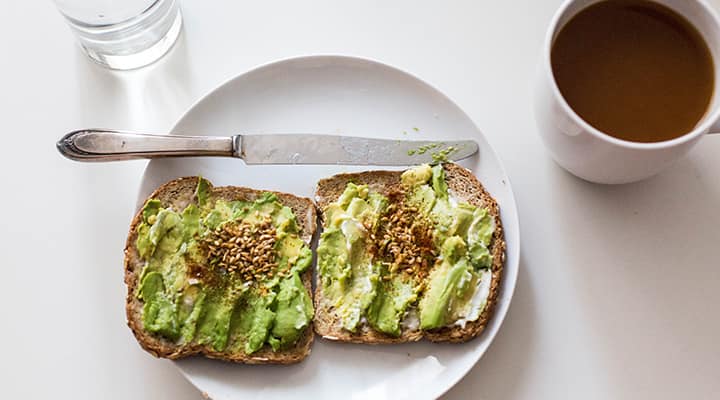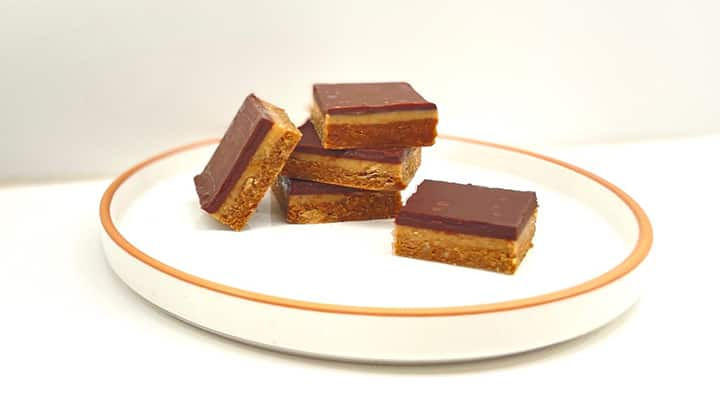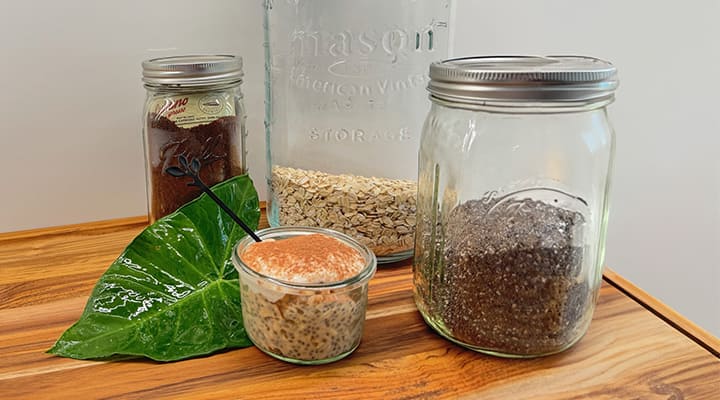
4 Avocado Lunchbox Ideas
Published: March 2022
If you are craving a smooth and buttery addition to your lunchbox, look no further than avocados! Botanically a fruit but typically enjoyed as a veggie, avocados are packed with healthy fats, vitamins, minerals and a boost of free-radical fighting antioxidants. Besides the tried-and-true guacamole, there are a plethora of ways to enjoy this creamy fruit at lunch time with other healthy pantry staples.
In fact, we have 4 ideas to easily add avocado to your lunchbox—including keto and vegan options.
How to eat avocados
First, pick the perfect avocado. Dark-colored avocados tend to be riper and will yield to firm gentle pressure in the palm of your hand. Place your washed avocado on a secure surface and slice slowly down the center lengthwise around the seed, twist and rotate the two halves apart. Remove the seed with a spoon, cut into wedges and pull the skin away from the inner green flesh.
What to make for lunch with avocado?
There are many delicious ways to prepare simple avocado lunch recipes. Everything from vegan lunches to keto-friendly lunch ideas to comfort foods you can enjoy on dreary days. Here are avocado lunch ideas – 4 ways!
1. Chicken-Less Pollo Burrito Lunch Box

Serves: 1
Extra Ingredients:
1 cup tortilla chips
1 cup mango
Chicken-Less Pollo Burrito Ingredients
1 large whole grain tortilla
1/3 avocado, mashed
1 tbsp lemon juice
Salt and pepper to taste
1/3 cup refried beans
1/4 cup salsa
1/3 cup shredded romaine
Instructions:
- Warm the tortilla in a large skillet over medium heat and place on a serving plate.
- In a small bowl, combine avocado with lemon juice, salt and pepper.
- Layer refried beans in the center of the tortilla and top with salsa, mashed avocado and romaine.
- To fold up burrito, bring one side of the tortilla up over the ingredients, fold in each side, then begin to tightly roll the burrito. Cut in half and add to your lunchbox.
- Add chips and mango to your lunchbox.
2. Avocado Caprese Turkey Salad Lunch Box
Serves: 1
Ingredients:
4 oz low-sodium deli turkey, rolled up and cut into bite-sized pieces
1 cup cherry tomatoes, chopped
1 oz fresh mozzarella, cut into bite-sized pieces
1/4 cup kalamata olives, sliced
1/2 avocado, cut into chunks
1 tbsp lemon juice
Salt and pepper to taste
2 tbsp chopped fresh basil
Instructions:
- Layer turkey, cherry tomatoes, mozzarella, olives and avocado chunks in your lunchbox. Drizzle lemon juice on top and season with salt, pepper.
- Top with fresh basil.
3. Keto Avocado Lunchbox
Serves: 1
Extra Ingredients:
2 tbsp brazil nuts
2 tbsp pecans
1/2 cup cucumber, sliced into coins
1/3 cup 100% cheese crisps
Avocado Tuna Boats Ingredients:
1 small avocado, halved and seed removed
1 can tuna packed in water, drained
1/4 cup avocado oil mayonnaise
2 tbsp celery, chopped
2 tbsp pickle relish
2 tbsp red onion, diced
1 tsp lemon juice
Salt and pepper to taste
Directions:
- Place tuna, mayonnaise, celery, relish, onion, lemon juice, salt and pepper in a medium mixing bowl and stir until combined. Serve mixture out of avocado halves and place in the lunch box.
- Add brazil nuts, pecans, cucumber and cheese crisps to the lunchbox.
4. Vegan Avocado Lunch Box
Serves: 1
Ingredients:
2 oz chickpea or whole grain pasta
1 medium ripe avocado, halved, seeded and peeled
2 tbsp California Estate Extra Virgin Olive Oil
1/4 cup fresh basil leaves
1 clove garlic
1 tbsp lemon juice
Salt and pepper to taste
1 cup cherry tomatoes, halved
Instructions:
- Cook pasta according to package instructions in a large pot on the stovetop. Drain and transfer back to the pot.
- Place avocado, olive oil, basil, garlic, lemon juice, salt and pepper in a food processor and process until smooth.
- Pour the sauce over the pasta, add cherry tomatoes and toss to combine. Transfer to your lunchbox.
Explore Our Best Food & Drink Formulas
Avocado Lunchbox: Tips for success

There are many ways to keep avocados from browning from the time of prepping to lunchtime.
1. Lemon juice–or any citrus for that matter!
Citrus fruits, such as lemons and limes, contain antioxidants that work against oxygen to slow down spoiling or browning of certain foods. Simply brush a little citrus juice across the flesh of a sliced avocado and store in an airtight container, or use a splash in a recipe using avocado. This should delay the browning process for about one day.
2. Create a barrier with oil
Oil can help prevent oxygen from reaching the flesh of an avocado. Brushing the exposed flesh of an avocado with olive oil or avocado oil can help create a barrier. Store in an airtight container in the fridge and this should prevent browning for about a day.
3. Avocados and onions–the perfect pair
Onions contain sulfur compounds that can slow the oxidation that causes browning. Dice up some onions, place in an airtight container and place your avocado half on top.
5 other ways to add avocado to your diet

Looking for quick fresh meals that incorporate avocado? Try these no-fail options:
- Blend it into a smoothie: Mild in taste, avocados add a creamy texture to smoothies plus a boost of staying power.
- Top a salad with avocado – a nutrient booster: Avocados are a unique fruit because they contain unsaturated fat, which can act as a nutrient booster for your favorite salad ingredients by helping increase the absorption of fat-soluble vitamins A, D, K and E.
- Stuff it: Avocados can serve as a creamy boat for baked eggs, tuna salad or taco fixings.
- Enjoy smashed avocado toast: Everyone loves a good slice of avocado toast. Simply smash a ripe avocado onto a piece of whole grain toasted bread and add our favorite toppings such as a fried egg, sliced tomatoes, a drizzle of olive oil or sprinkle of salt and pepper.
- Use it as a mayonnaise replacement: Replace mayo on a sandwich or in a homemade tuna salad with creamy avocado to up the good fats and cut back on saturated fat.
Can you meal prep with avocados?

While unripe avocados should be kept at room temperature to gradually soften, ripe avocados should be eaten immediately or moved to the fridge where the cold temperature can extend their shelf life by a few days.
Needless to say, avocados are pretty high maintenance. Once you start slicing and dicing avocados, you’ve got a short amount of time to use them before they start turning brown. This is because avocados contain an enzyme called polyphenol oxidase, which turns the flesh brown when exposed to air.
For that reason, avocado should be a last-minute addition when you’re packing lunch, so it will be at its freshest when you sit down to eat. If you are incorporating it into a recipe like a burrito or pasta sauce, it is best to prep and enjoy it the day of.
Are avocados part of any diet?

Avocados can fit into a range of eating styles including vegan, vegetarian, low-carb, paleo, keto and Mediterranean.
The keto diet has become increasingly popular over the years. It is a diet characterized by high fat and low carbohydrate intake. Because avocados are primarily fat (the good kind), they fit in to the keto diet.
The Mediterranean diet has proven to be one of the best lifestyle strategies for longevity and promoting cardiovascular and cognitive health. The diet allows for a wide variety of nutritious foods such as fruit, vegetables, whole grains, legumes, nuts, seeds fatty fish and good fats such as those found in avocado.
Heart-health benefits of avocados
While many may be deterred by the high fat content of avocados, you should know that they contain the good kind of fat – namely, unsaturated fats that support heart health and can promote the absorption of other vitamins and minerals. The American Heart Association says that when eaten in moderation, both kinds of unsaturated fats – polyunsaturated and monounsaturated — may help maintain your already-healthy blood cholesterol when used in place of saturated and trans fats.
In fact, a 2019 randomized, controlled feeding study conducted at Penn State found that eating one avocado a day may help maintain already-healthy LDL cholesterol.
It is never too early to embrace heart-healthy eating and lifestyle habits.
Can you meet your nutritional needs to support heart health from an avocado lunchbox?

Incorporating a variety of whole food ingredients into your meals is key to meeting your nutritional needs. However, there are certain nutrients that are harder to get from food alone that play a particular role in supporting heart health.
Vitamin K:
Although found in widely consumed foods such as dark leafy greens, research suggests vitamin K1 may be difficult to absorb and utilize from food sources since it’s tightly bound to plant fibers.
Vitamin K2 is found in large amounts in the traditional Japanese fermented food called natto and to a very small degree in high fat dairy products, fish, liver, meat and eggs but not nearly enough to meet your needs when these foods are consumed in moderation.
Vitamin K is crucial in relation to vitamin D. They particularly work together to direct calcium into bones and support against build up in the blood that can potentially have health impacts.
Life Extension Super K combines vitamin K1 and two forms of vitamin K2 in a once-daily vitamin K supplement that can help fill in gaps and ultimately support heart health.CoQ10:
Coenzyme Q10, also known as CoQ10, is produced by the body naturally and found in certain foods, primarily organ meat. CoQ10 is recognized for its ability to provide cardiovascular support, and promote healthy cellular energy production. Since CoQ10 production decreases with age, adults may benefit from supplementation for heart health.Omega-3:
Omega-3 fats are known for their ability to support cardiovascular health by maintaining already-healthy LDL and HDL cholesterol and triglyceride levels. The EPA and DHA omega-3 fats play the biggest role in terms of cardiovascular support and are the forms found primarily in fish. If you do not often consume fish such as salmon, a supplement may be of benefit.
References:
- Bohn, K. “One avocado a day helps lower ‘bad’ cholesterol for hearth healthy benefits,” PSU.edu, October 2019. https://www.psu.edu/news/research/story/one-avocado-day-helps-lower-bad-cholesterol-heart-healthy-benefits/
- Higon, J PhD. et al. “Vitamin K Summary,” Data on file.
- Kelley-Hedgepeth, A MD. “Omega-3 fatty acids and the heart: New evidence, more questions,” Harvard Health Publishing, March 2021. https://www.health.harvard.edu/blog/omega-3-fatty-acids-and-the-heart-new-evidence-more-questions-2021032422213
- Moon, K. et al. “Recent Trends in Controlling the Enzymatic Browning of Fruit and Vegetable Products,” Molecules, June 2020. https://www.ncbi.nlm.nih.gov/pmc/articles/PMC7355983/
- van Ballegooijen, A et al. “The Role of Vitamin K Status in Cardiovascular Health: Evidence from Observational and Clinical Studies,” Current nutrition reports, July 2017. https://www.ncbi.nlm.nih.gov/pmc/articles/PMC5585988/
- “The Skinny on Fats,” Heart.org, November 2020. https://www.heart.org/en/health-topics/cholesterol/prevention-and-treatment-of-high-cholesterol-hyperlipidemia/the-skinny-on-fats
Always be in the know!
Access the latest deals, wellness news, expert health tips & more!






